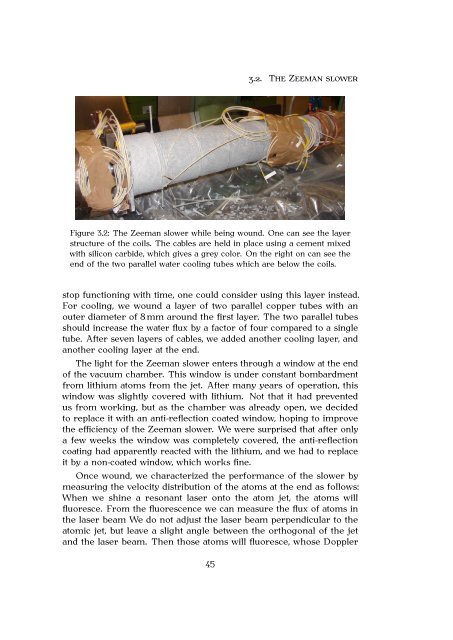Martin Teichmann Atomes de lithium-6 ultra froids dans la ... - TEL
Martin Teichmann Atomes de lithium-6 ultra froids dans la ... - TEL
Martin Teichmann Atomes de lithium-6 ultra froids dans la ... - TEL
Create successful ePaper yourself
Turn your PDF publications into a flip-book with our unique Google optimized e-Paper software.
3.2. THE ZEEMAN SLOWER<br />
Figure 3.2: The Zeeman slower while being wound. One can see the <strong>la</strong>yer<br />
structure of the coils. The cables are held in p<strong>la</strong>ce using a cement mixed<br />
with silicon carbi<strong>de</strong>, which gives a grey color. On the right on can see the<br />
end of the two parallel water cooling tubes which are below the coils.<br />
stop functioning with time, one could consi<strong>de</strong>r using this <strong>la</strong>yer instead.<br />
For cooling, we wound a <strong>la</strong>yer of two parallel copper tubes with an<br />
outer diameter of 8 mm around the first <strong>la</strong>yer. The two parallel tubes<br />
should increase the water flux by a factor of four compared to a single<br />
tube. After seven <strong>la</strong>yers of cables, we ad<strong>de</strong>d another cooling <strong>la</strong>yer, and<br />
another cooling <strong>la</strong>yer at the end.<br />
The light for the Zeeman slower enters through a window at the end<br />
of the vacuum chamber. This window is un<strong>de</strong>r constant bombardment<br />
from <strong>lithium</strong> atoms from the jet. After many years of operation, this<br />
window was slightly covered with <strong>lithium</strong>. Not that it had prevented<br />
us from working, but as the chamber was already open, we <strong>de</strong>ci<strong>de</strong>d<br />
to rep<strong>la</strong>ce it with an anti-reflection coated window, hoping to improve<br />
the efficiency of the Zeeman slower. We were surprised that after only<br />
a few weeks the window was completely covered, the anti-reflection<br />
coating had apparently reacted with the <strong>lithium</strong>, and we had to rep<strong>la</strong>ce<br />
it by a non-coated window, which works fine.<br />
Once wound, we characterized the performance of the slower by<br />
measuring the velocity distribution of the atoms at the end as follows:<br />
When we shine a resonant <strong>la</strong>ser onto the atom jet, the atoms will<br />
fluoresce. From the fluorescence we can measure the flux of atoms in<br />
the <strong>la</strong>ser beam We do not adjust the <strong>la</strong>ser beam perpendicu<strong>la</strong>r to the<br />
atomic jet, but leave a slight angle between the orthogonal of the jet<br />
and the <strong>la</strong>ser beam. Then those atoms will fluoresce, whose Doppler<br />
45

















